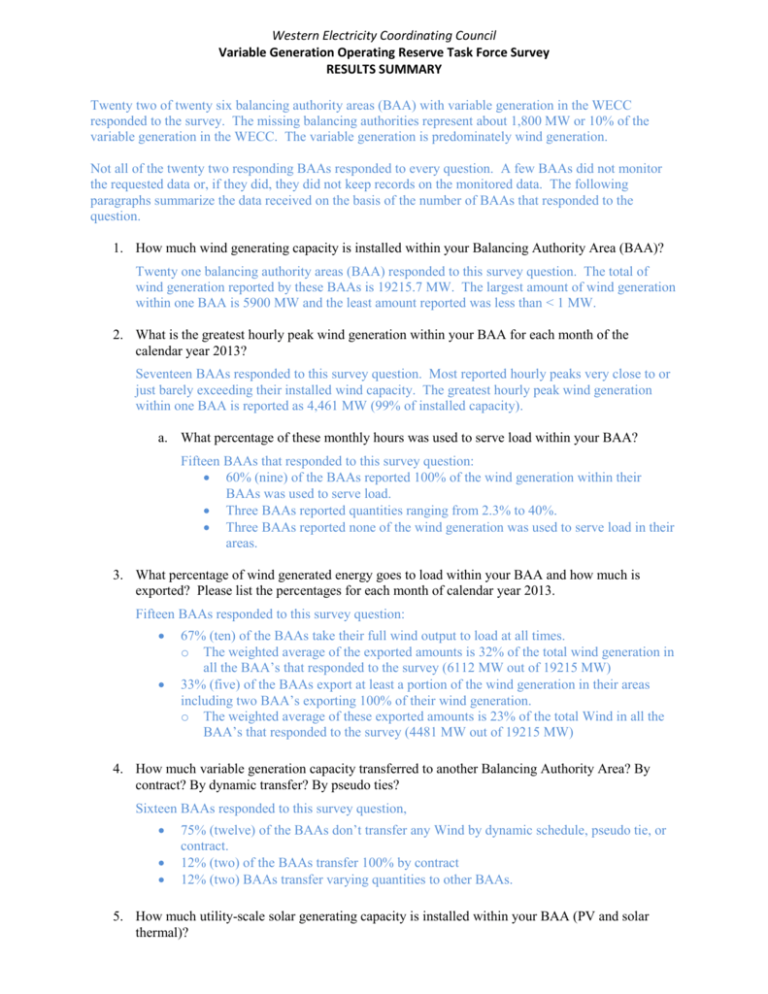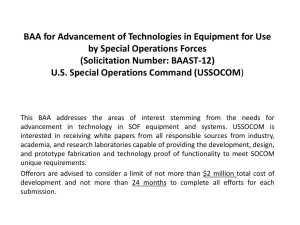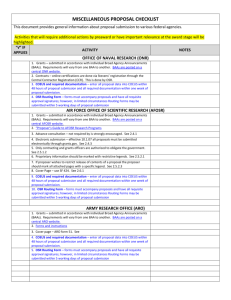Survey Summary Report for 2013 - Western Electricity Coordinating
advertisement

Western Electricity Coordinating Council Variable Generation Operating Reserve Task Force Survey RESULTS SUMMARY Twenty two of twenty six balancing authority areas (BAA) with variable generation in the WECC responded to the survey. The missing balancing authorities represent about 1,800 MW or 10% of the variable generation in the WECC. The variable generation is predominately wind generation. Not all of the twenty two responding BAAs responded to every question. A few BAAs did not monitor the requested data or, if they did, they did not keep records on the monitored data. The following paragraphs summarize the data received on the basis of the number of BAAs that responded to the question. 1. How much wind generating capacity is installed within your Balancing Authority Area (BAA)? Twenty one balancing authority areas (BAA) responded to this survey question. The total of wind generation reported by these BAAs is 19215.7 MW. The largest amount of wind generation within one BAA is 5900 MW and the least amount reported was less than < 1 MW. 2. What is the greatest hourly peak wind generation within your BAA for each month of the calendar year 2013? Seventeen BAAs responded to this survey question. Most reported hourly peaks very close to or just barely exceeding their installed wind capacity. The greatest hourly peak wind generation within one BAA is reported as 4,461 MW (99% of installed capacity). a. What percentage of these monthly hours was used to serve load within your BAA? Fifteen BAAs that responded to this survey question: 60% (nine) of the BAAs reported 100% of the wind generation within their BAAs was used to serve load. Three BAAs reported quantities ranging from 2.3% to 40%. Three BAAs reported none of the wind generation was used to serve load in their areas. 3. What percentage of wind generated energy goes to load within your BAA and how much is exported? Please list the percentages for each month of calendar year 2013. Fifteen BAAs responded to this survey question: 67% (ten) of the BAAs take their full wind output to load at all times. o The weighted average of the exported amounts is 32% of the total wind generation in all the BAA’s that responded to the survey (6112 MW out of 19215 MW) 33% (five) of the BAAs export at least a portion of the wind generation in their areas including two BAA’s exporting 100% of their wind generation. o The weighted average of these exported amounts is 23% of the total Wind in all the BAA’s that responded to the survey (4481 MW out of 19215 MW) 4. How much variable generation capacity transferred to another Balancing Authority Area? By contract? By dynamic transfer? By pseudo ties? Sixteen BAAs responded to this survey question, 75% (twelve) of the BAAs don’t transfer any Wind by dynamic schedule, pseudo tie, or contract. 12% (two) of the BAAs transfer 100% by contract 12% (two) BAAs transfer varying quantities to other BAAs. 5. How much utility-scale solar generating capacity is installed within your BAA (PV and solar thermal)? Western Electricity Coordinating Council Variable Generation Operating Reserve Task Force Survey RESULTS SUMMARY Nineteen BAAs responded to this survey question, 63% (twelve) of the BAAs have utility-scale solar generation installed. o The total amount of utility-scale solar generation installed is 6185 MW. The largest amount of utility-scale generating capacity installed within one BAA is 5499 MW 6. How much distributed solar (PV) generating capacity is installed within your BAA? Fourteen BAAs responded to this survey question, 86% (twelve) of the BAAs have distributed solar (PV) generation installed. o The total amount of utility-scale solar generation installed is 2576 MW. The largest amount of distributed solar (PV) generation installed within one BAA is 2000 MW. 7. What is the maximum loss of wind generation over a 15-minute period you have experienced within your BAA? a. How much due to high-speed cutout? Fifteen BAAs responded to this survey question, 87% (Thirteen) BAAs reported losing various amount of their wind generation due to high-speed cutout over a 15-minute period. o Two BAAs reported 100% of their wind generation has been lost due to high-speed cutout. o The largest amount of wind generation lost due to high-speed cutout is 958 MW. b. How much due to wind variability dropping below minimum levels to sustain generation? Seven BAAs responded to this survey question, Although all seven BAAs reported losing various amounts of wind generation due to wind variability, two BAAs reported 100% of their wind generation was not sustainable due to wind variability. c. How much due to temperature extremes? Low and high. None of the twenty two BAAs responding to this survey question keep records for analyzing losses of wind generation due to temperature extremes. d. How much due to frequency variations? None of the twenty two BAAs responding to this survey question keep records for analyzing losses of wind generation due to frequency variations. e. How much due to a loss of a physical element of the BES? Six BAAs responded to this survey question, One BAA reported losing 100% of its wind generation due to loss of a physical element. Two others reported losing 50%. f. How much due to other causes? Four BAAs responded to this survey question, One BAA reported losing all of its wind generation due to a distribution feeder outage. The wind farm is connected to the feeder. Western Electricity Coordinating Council Variable Generation Operating Reserve Task Force Survey RESULTS SUMMARY 8. What is the maximum loss of solar generation over a 15-minute period you have experienced within your BAA? Eight BAAs that have solar generation and data to track loss of solar generation responded to this survey question. The maximum loss of solar generation over a 15-minute period varied from < 1 MW to 495 MW (about 9% of their installed solar capacity). 9. Does your BA, have dispatch control over the wind and solar generation within your BAA? Twenty BAAs responded to this survey question, Thirteen BAAs have dispatch control over the variable generation in their BAAs. Seven BAAs do not have dispatch control over the variable generation in their BAAs. 10. Does your BAA have the ability to disconnect a variable generation source for reliability? Twenty BAAs responded to this survey question, a. If so, under what circumstances can you exercise this authority? AESO – Yes, as required to maintain reliability AVA – Yes, Avista may curtail receipt of the output if Avista, in its sole discretion, reasonably determines that such curtailment is necessary and that the failure to do so may: (a) endanger any person or property, or Avista's electric system, or any electric system with which Avista's system is interconnected; (b) cause, or contribute to, reliability or an imminent significant disruption of electric service to Avista's or another utility's customers; (c) cause, contribute to, or necessitate operation of any of Avista's hydroelectric projects in violation of any license or other regulatory requirements; (d) interfere with any construction, installation, inspection, testing, repair, replacement, improvement, alteration, modification, operation, use or maintenance of, or addition to, Avista's electric system or other property of Avista; or (e) if such curtailment is required for Avista's compliance with any applicable law or regulatory requirement. BANC – Yes, for reliability or system emergency reasons. BPA – Yes, for reliability concerns at discretion of System Dispatchers. CISO – Yes, under real-time congestion or during a staged emergency. CFE – Yes, if their operations causes over generation or voltage. GWA & WWA - Yes, we would bring resource to 0 MW generation, but would not normally disconnect from grid. So, it is not known IPC – Yes, when, in IPC’s reasonable judgment or in accordance with Good Utility Practice (as defined in IPC’s Tariff Schedule 72), a condition or conditions exist which may impact the integrity, safety, or reliability of IPC’s electrical system. In addition, IPC may interrupt wind generation on its system so as to avoid violation of an environmental law or regulation, primarily associated with the operation of IPC’s hydro system. LDWP – At LDWP's discretion NEVP – Yes, for the following: 1. certain line outages can force generation through the interconnection to get back to the NV Energy load. Such action is not allowed without sufficient transmission rights through TOPs external to NV Energy. Without the proper transmission rights, the generation is curtailed. 2. Low load periods may force down non-PV/wind generation leaving insufficient contingency reserve. In that condition, generation might be curtailed. 3. The NV Energy northern system has established an export limit. In low low periods, if zonal export exceeds the limit, generation can be curtailed. PACE & PACW – Yes, for reliability PGE – Other than opening load distribution feeders that the generation is located on, no. Western Electricity Coordinating Council Variable Generation Operating Reserve Task Force Survey RESULTS SUMMARY PSC – Yes, BHCE has the ability to disconnect a variable generation source. When the reliability of the BES is threatened due to the wind generation or a transmission element associated with the wind generation. If variable generation is causing a risk to the reliability of the interconnected grid and the best alternative is to disconnect the generation. PSE – Yes. The ability to curtail either a RAS or operating procedure or disconnect generation for reliability purposes. Authority is outlined under the generator interconnection agreement(s), transmission agreement(s) and third party SOP and dispatch standing orders. SRP – Yes, when system reliability is involved or when transmission capacity is not available. TEPC – Yes, we can do so for safety. Such capability is only installed for generation over 3 MW. TID – No WACM – System Reliability, transmission constraints b. Have use exercised such authority? If so how much? AESO – Yes, full wind farm curtailments at times due to overload for next contingency. AVA – Several times on the small solar to isolate the system for repairs. BANC – No. BPA – No. CISO – Yes, this authority has been exercised. CFE – No. GWA& WWA – No. IPC – Yes, on eighteen separate occasions. LDWP – Yes, but rarely. NEVP – Yes, for condition #1 above. PACE & PACW – Yes, up to 262 MW capacity. PSC – Yes, curtailed due to a BES outage up to the full plant output of 29 MW. PSE – PSE has issued pro rata curtailments due to affected system dispatch standing orders which can occur several times during the course of a year. SRP – No. TEPC – No. TID – No. WACM – Yes, 45 MW curtailed due to transmission outage. 11. Does your BA, have the ability to deny/modify a schedule regarding wind and solar generation within your BAA? Twenty BAAs responded to this survey question, a. If so, under what circumstances can you exercise this authority? The vast majority of respondents can modify a schedule for reliability, emergency conditions, market conditions, reserve depletion, or transmission capacity issues. 12. Who (BAA or individual farms) provides generation forecasting and how frequently are forecasts performed? The responses to this question are unique for each respondent. The majority indicate that forecasting is occurring at either the BAA’s or individual generator level. The level of forecasting granularity spans from 5-15 minutes to hourly forecasts. Some generators are providing longer term data from a week ahead to day-ahead forecasts. 13. What method does your BAA follow, on a day-ahead planning basis, to establish an hourly regulation capacity requirement? Western Electricity Coordinating Council Variable Generation Operating Reserve Task Force Survey RESULTS SUMMARY Eighteen BAAs responded to this survey question, BPA – BPA holds a set amount of regulating reserves on a 24/7 basis, that can change monthly based on the installed capacity of all generation in the BAA (including wind, solar, thermal, and hydro), and on the predicted load growth by fiscal year. CISO – Day-ahead. CFE – The required regulation capacity on a day-ahead planning basis is established as the 1% of the forecasted hourly load. GWA & WWA – The majority of our regulation planning is done hour-ahead. IPCO – Idaho Power does not follow a specific method for hourly regulation capacity, the focus is more on the load resource balance for operating reserve. Our EMS system calculates the regulation capacity requirement in real-time which effects operating reserve balance. LDWP – LDWP has a fixed hourly regulation capacity requirement NEVP – NV Energy examined two years of data for wind and solar, determining the average variation for each season. NV Energy included the effect of load variation in calculation. PACE & PACW – PacifiCorp utilizes logic derived from the Wind Integration Study (WIS) cited in the companies Integrated Resource Plan (Appendix H) to calculate regulating reserve requirement. The regulating reserve requirement is intended to manage the uncertainty and variability around the hourly ramps. PGE – The Portland General Electric BAA always maintains a minimum of +/-10 MW of regulation capacity and increases as necessary to maintain compliance with CPS. PSC – We inform the BAA on a day-ahead planning basis who then schedules it according to their procedure PSE – The Trade floor will forecast capacity of wind farm base on wind forecast and enter into MCG TEPC – TEPC participates in the Southwest Reserve Share Group. TEPM provides a day-ahead forecast of TEP’s firm commitment, which is then uploaded into the Reserve Share System. The Reserve Share System automatically calculates a forecast of the next day’s contingency reserve. These reserves are treated as the minimum amount of reserves carried for the next day. TID – We look at the ramp from one hour load forecast to the next hour load forecast and then add load uncertainty buffer WACM – All entities within the BAA provide their own load forecasts and WACM consolidates those for the BAA next day load and generation projections a. Are there unique components established for wind, solar or load contributions to the requirement? AVA – Yes. BPA – Yes. CISO – The ISO does procure regulation needs on a system level. CFE – Since our renewables are so small, their loss is not reflected on the regulation capacity requirement GWA & WWA – 100% of our planning is for wind. IPCO – We attempt to calculate the INC and DEC wind regulating margin based on the actual online wind generation. This calculation is based on 25% of the online wind generation with a cap applied. The cap is reviewed quarterly based on past data. LDWP – No. NEVP – No. PACE & PACW – The regulating reserve methodology derived from the WIS includes unique components for wind and load. These components are inputs for a total root sum square calculation that acknowledges characteristics of each individual component. Solar contributions are not included. Western Electricity Coordinating Council Variable Generation Operating Reserve Task Force Survey RESULTS SUMMARY PGE – No. PSE – No. SRP – During the day-ahead planning process, on an hour to hour basis, load and obligations are balanced with supply consisting of generation resources and power purchases. Spinning and non-spinning reserves as required by NERC/WECC are included in the plan. Additionally, regulation reserves are included for load variations and variable generation. This amount is normally small in magnitude but may be increased during the day of delivery based on system conditions TEPC – No. TID – No. WACM – No. b. Are there unique components established for wind, solar or load contributions to the requirement? i. Do these requirements change throughout the day? AVA – Yes. BPA – No. CISO – Yes. CFE – No. IPCO – No. LDWP – No. NEVP – No. PACE & PACW – The regulating requirements are a function of load and wind forecasts. To the extent these forecasted load and winds change throughout the day, the calculated regulation requirement will change. PSC – PSCo: Flex Reserves to guard against a loss of wind generation due to loss of wind speeds are continuously calculated based on the location and volume of wind generation of wind generation assets controlled by PSC. SRP – No. TID – No. ii. If so, how do they change? AVA – Available flexible capacity, load changes, generation changes, wind speed changes, temperature changes CISO – Both regulation up and regulation down requirements vary by hour PACE & PACW – The regulating requirements are a function of load and wind forecasts. Monthly load and wind component tables consist of 20 bins for which a forecast value of a given magnitude produces a regulating requirement component. These components are inputs for a total root sum square calculation that acknowledges characteristics of each individual component. ` 14. Do you forecast variable generation production? If so, Seventeen BAAs responded to this survey question. A vast majority of BAAs do forecast variable generation production, but not all. a. How often do you forecast? 24-hour, hourly, within hour? Most forecast hourly, but many are more granular to the 5 minute level. Some indicate a day-ahead or preschedule hourly forecast. Some BAAs rely on the Generator Operator (GO) to perform the forecasting. Western Electricity Coordinating Council Variable Generation Operating Reserve Task Force Survey RESULTS SUMMARY b. How accurate are your forecasts? Most BAAs report a reasonable accuracy of the forecasts, but others indicate a large variance based on volatile wind/solar conditions. c. Do you subscribe to a commercial wind and/or solar forecasting service? About 50% of BAA respondents subscribe to a commercial forecasting service. d. Do you compare your forecast to the plant owner’s schedule? If yes, do you do anything about it? Nearly all BAA respondents do not compare the forecast to the GO schedule. Few, on occasion, do anything in real-time to address any variance. 15. Would you support a common regional method for determining the amount of regulating reserve required due to increased variable generation? Affirmative, Unconditional: Comision Federal de Electricidad (CFE) NV Energy (NEVP) Portland General Electric (PGE) Turlock Irrigation District (TID) Affirmative, Conditional: (conditional language listed below) Avista (AVA) Bonneville Power Administration (BPA) California ISO (CISO) Glacier Wind Energy (GWA) Idaho Power (IPC) Los Angeles Department of Water and Power (LDWP) NaturEner Wind Watch (WWA) Public Service Company of Colorado (PSC) Puget Sound Energy (PSE) Salt River Project (SRP) Western Area Colorado Missouri (WACM) Negative: Alberta (AESO) – with enthusiasm. Balancing Authority of Northern California (BANC) Tucson Electric Power (TEPC) Not Sure / No Response: Chelan (CHPD) El Paso Electric (EPE) PacifiCorp (PACE and PACW) Conditional Responses: AVA BPA We would be interested if regional methodology is flexible and does not significantly increase our regulating reserve requirement. Assuming an open and collaborative drafting team approach among all of WECC, Western Electricity Coordinating Council Variable Generation Operating Reserve Task Force Survey RESULTS SUMMARY BPA would support the development of a common regional method for determining the amount of regulating reserves for variable generation and all consumers of regulating reserves (including Load and non-controlling generation in the BAA). CISO The regulation requirement for each BAA varies due to several reasons such as load, wind and solar variability and their forecast errors in different timeframes. Regulation requirements is also impacted by market timelines and when load, wind and solar forecast are available to run market applications. The ISO could support a common regional method providing the regional method produces hourly upward and downward regulation needs that are close to what the ISO’s actual dispatch needs. GWA Caution should be exercised in trying to impose a “one solution fits all”. Different fuel types require different levels of regulating reserve. Different balancing techniques and resources will require different levels of regulating reserves. IPC A common methodology for calculating regulating reserve could be beneficial especially for variable resources. But we would be reluctant to support a regional standard or policy that would make this method a requirement. LDWP At this point in time, LDWP does not see the need for a common regional method for determining the amount of regulating reserve required due to increased variable generation. WWA Caution should be exercised in trying to impose a “one solution fits all”. Different fuel types require different levels of regulating reserve. Different balancing techniques and resources will require different levels of regulating reserves. PSC Yes, that would be a great way to make planning consistent across BAA’s and pseudo BA’s. However BHCE supports the following PSC statement: PSC carries regulating reserves specifically to guard against a large loss of wind generation due to loss of wind speeds. PSC believes that each BAA has unique challenges determined by the make-up of their generation portfolio. Therefore a single regional method may not be appropriate. On the other hand, a regional method for determining regulating reserves may lower the total regulating reserves required from each BAA due to the geographic diversity of the wind resources. If a regional approach can match or improve both reliability and costs for PSC ratepayers, then PSC would support a regional approach. PSE We do not see an issue with the current requirement R1 from BAL-002-WECC-2 supplying adequate contingency reserve. SRP No. A regional method would overburden BA’s that have few or no variable generation sources. This would only be an acceptable proposal if the regulations were BAA specific and BA’s provided reserves for their own variable generation sources. WACM We would support the consideration/creation of a common regional method.






